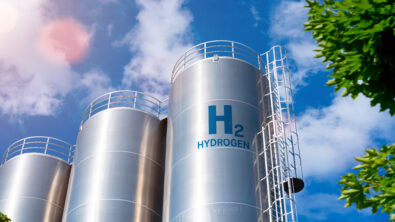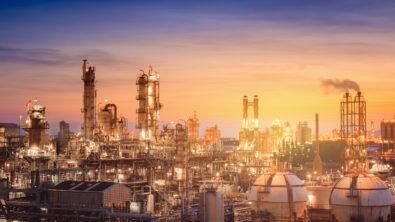How Siemens and SAP are Building a More Sustainable Future for Energy

Editor’s note: We’re excited to share an update from ADIPEC 2023 where Siemens Digital Industries Software and SAP highlighted our joint offering for capital asset project and lifecycle management at this premier energy industry event.
ADIPEC 2023, hosted by ADNOC from 2 – 5 October 2023, brought together 2,200+ businesses along with 184,000+ thought leaders and energy professionals from 160 countries. The theme was “Decarbonizing. Faster. Together.” Enjoy this latest update!
As concern over climate change grows, the energy sector faces growing pressure to operate more sustainably. Governments and other public entities increasingly use regulations, policies, taxes, and other incentives to spur energy companies to reduce their carbon footprint.
To comply with these new directives, companies must find more operational efficiencies to minimize their environmental impact, for example, by standardizing a pipeline inspection schedule. That would ensure equipment is maintained and performs at its peak, which, in turn, proactively prevents harmful greenhouse gas emissions.
But a single process change won’t be enough. To make the most meaningful change, companies must look for ways to optimize all their capital assets, from buildings to drilling rigs to wind turbines.
That’s why combined solutions from Siemens Digital Industries Software and SAP bring great value to the energy and utilities sector. This approach enables managing capital-intensive operations and the many large-scale assets found in energy production and distribution throughout the lifecycle—from planning to development to operations and then disposal. Companies use these combined solutions to increase transparency across their assets. Then, teams can make better-informed decisions and optimize operations to be more eco-friendly.
The Siemens Digital Industries Software and SAP joint offering
This blog takes a closer look at the advanced capital-intensive projects and asset lifecycle management solutions made possible via the integrated software solutions from Siemens Digital Industries Software and SAP.
- Siemens Digital Industries Software provides lifecycle management to help customers in asset-intensive industries establish a lifecycle digital thread, connecting information across functional domains and operational disciplines.
- SAP ties lifecycle management together with enterprise resource planning (S/4HANA) for capital asset-intensive industries and with solutions including SAP Intelligent Asset Management (IAM) and SAP Enterprise Portfolio Project Management (EPPM), delivering a single digital thread.
Together, Siemens Digital Industries Software and SAP integrated solutions provide capabilities that set up energy companies for leaner operations, which ultimately leads to more sustainable outcomes.

Crossing silos
It’s an unfortunate fact that energy and utilities companies work in silos. That means operations don’t always work closely with maintenance. Engineering can impact manufacturing in unintended ways. Project handoff coordination is limited when organizations operate in silos with different toolsets and data models that weren’t designed to connect. This blinkered approach helps teams remain focused on their immediate goals but leads to inefficiencies for the overall company.
Siloed companies struggle to access information coming from across the company. No common thread can reliably tie together all the data related to one or more capital assets, their history, or their operating data. This incomplete view leaves decision-makers without the tools they need to accurately analyze or optimize operations for sustainability.
How do these companies streamline the delivery of capital projects, improve operational efficiency, and reduce execution risk? When teams fail to share vital information, companies can make risky decisions, scramble to react to change orders, and lose valuable time.
Siemens Digital Industries Software and SAP partnership provides the bridge
A combined solution offering by Siemens Digital Industries Software and SAP can resolve these issues. The integrated solutions combine powerful capabilities collectively known as SAP Capital Project Engineering Management (CaPEM), including:
- Teamcenter for CALM (Capital Asset Lifecycle Management)
Teamcenter is well-known for its ability to manage product data, processes, and collaboration throughout a product’s lifecycle, whether that product is a hearing aid or a jet plane. This same expertise, when applied to energy and utility companies, is crucial for capital assets to ensure optimal performance throughout design, production and operations. - SAP S/4HANA, SAP Enterprise Portfolio and Project Management, SAP Intelligent Asset Management and SAP PLM Systems Integration
These solutions manage business processes and bi-directional data transfers with and between other platforms.
The integration means that real-time, bi-directional updates can flow between the solutions. These include digital engineering artifacts—such as CAD models, bills of materials (BOMs), and requirements—as well as operational plant data. The result is that siloed operations no longer hold back the company as it works to create leaner processes and more optimized assets. Team members have the information they need to make better-informed decisions, streamline asset delivery and improve productivity and efficiency.
Digital twins break down silos, promote asset visibility
Siemens Digital Industries Software offers lifecycle management with Teamcenter for CALM, which allows teams to collect and monitor data from capital assets using digital twins. A digital twin is a virtual replicate of any asset that maintains a connection to the physical item—so that any change that takes place in real life is reflected in the virtual model.
Here’s how that can benefit energy companies: Imagine a situation where a plant uses boilers to produce steam to drive manufacturing processes. The company outfits the boilers with sensors that monitor the pressure and temperature inside the tanks, as well as the flame used to heat the boiler. The company creates a digital twin that uses that sensor data to maintain a dashboard with the boiler’s current and historical conditions.
The system alerts managers when urgent conditions arise. But it also gives engineers data to maintain and optimize the system’s health. For example, sensors can pick up slightly higher-than-necessary output in the boiler. If technicians lower the flame, they could conserve significant energy with no negative consequence to the overall plant operation.
Companies can also add maintenance schedules, downtime events, part changes, and new specifications. When all this information is centralized, companies can more easily optimize asset performance.

Sustainability matters
When companies need to find energy savings and operate more sustainably, the Siemens Digital Industries Software and SAP combined solutions help companies accurately plan and optimize capital assets. Engineers use these tools to quickly identify poorly performing equipment, parts needing updates, and processes that have decayed over time. This increased visibility into operating systems, as well as access to aggregated engineering data, means companies gain new insights to choose more responsible designs, materials, equipment, and sourcing options—and can do so earlier and with greater confidence.
Optimized processes throughout the capital asset’s lifecycle
In the energy and utilities sector, expensive plants and equipment must last for decades. Companies need methods to keep their investments maintained and running. At the same time, they must remain flexible enough to adapt to change—such as when a more efficient replacement part or a better energy-saving material becomes available. The Siemens and SAP solutions help companies deliver projects more quickly—and then optimize and maintain those projects throughout their lifecycle.
The digital twin provides the backbone that connects capital assets throughout the company and improves visibility. Engineers use this constant real-time data to refine and improve performance, making the energy sector more adaptive, no matter what the future holds.
Integration of Teamcenter for CALM within SAP CaPEM improves sustainability with visibility throughout the supply chain of aggregated engineering data that facilitates responsible design, materials, equipment and sourcing decisions early in the planning stage. Once in operations, companies can draw conclusions relating to maintenance, production, and quality—reducing costs and preventing disruption and resource waste.
It’s time for data-driven decision-making
For a more efficient, sustainable future in the energy and utilities sector, companies will benefit from using the joint Siemens Digital Industries Software and SAP solutions. With a comprehensive digital twin at the center of the technology, companies can look forward to a more efficient and adaptive future. This data environment is organized, structured, and available to all stakeholders, breaking down silos between departments. The result is better use of company assets and improved decision-making throughout the enterprise.
Learn more
Listen to our podcast with industry experts from Siemens and SAP.
Comments
Leave a Reply
You must be logged in to post a comment.



Atlas FUSD is a unified student data system for the Fremont Unified School District. It allows students, parents, and staff to access grades, attendance, and other academic information in one place. This platform enhances communication and supports academic progress within the district. https://www.atlasfusd.com/
Atlas FUSD is Fremont Unified School District’s unified student data system. It enables students, parents, and faculty to view grades, attendance, and other academic data in one location. This tool improves communication and academic accomplishment across the district.
friday night funkin’
This partnership between Siemens Digital Industries Software and SAP is truly transforming the energy sector by optimizing capital assets and enhancing sustainability. By integrating lifecycle management tools like Teamcenter for CALM and leveraging digital twins, companies can reduce inefficiencies and make data-driven decisions that improve both operational efficiency and environmental impact. This is an exciting step toward a greener, more sustainable future. For more insights on how to optimize asset performance, visit Arrests.org for further information on the role of data in driving sustainable practices across industries.
The energy sector is facing significant pressure to adopt more sustainable practices, and the integrated solutions from Siemens Digital Industries Software and SAP are a step in the right direction. By connecting lifecycle management with enterprise resource planning, these solutions optimize operations and promote eco-friendly practices. For those looking to explore more data-driven platforms, NY Inmate Search offers an easy-to-navigate resource for accessing legal and arrest records, supporting informed decision-making across various industries, including energy.
As the energy sector adapts to growing sustainability demands, leveraging integrated solutions becomes essential for meaningful impact. Standardizing processes like pipeline inspections is a great start, but comprehensive optimization of all capital assets—buildings, rigs, and turbines—is the key to reducing the carbon footprint. Tools like the Siemens and SAP partnership empower energy companies to manage their assets lifecycle effectively, boosting transparency and eco-conscious decision-making. For those exploring data-driven insights in other sectors, resources like KY Criminal Database demonstrate the potential of technology in fostering transparency and informed choices. Together, these innovations pave the way for a more sustainable future.
This collaboration between Siemens Digital Industries Software and SAP is a game-changer for the energy sector, enabling improved asset visibility and optimized lifecycle management for greater sustainability. For those looking to streamline operations or enhance decision-making through data-driven insights, these integrated solutions are invaluable. Discover how tools like Inmate Locator can help you manage and access critical data effectively: Smart Square access. Transform your approach with technology that bridges silos and promotes sustainability.
Great insights! I completely agree that standardizing processes like pipeline inspections is just the tip of the iceberg when it comes to achieving sustainability in the energy sector. The Siemens and SAP partnership is a fantastic example of how integrated tools can streamline asset management and promote eco-friendly decision-making. It’s also interesting how you connected this to the broader potential of technology in other sectors, like the KY Criminal Database for transparency. It really highlights how data-driven solutions can create positive ripple effects across industries. The future definitely looks promising with these kinds of innovations! Receiptify
Great insight into how Siemens and SAP are breaking down silos in the energy sector. Their integrated lifecycle and asset Doodle Baseball management solutions show how digital twins and real-time data sharing can drive both efficiency and sustainability.
It’s inspiring to see companies like Siemens and SAP taking steps toward sustainable energy solutions. For anyone interested in the broader impact on local communities, tools like https://volusiacountypropertyappraiser.org can provide valuable insights into property trends and land use patterns. Understanding these records helps track developments and sustainability efforts more effectively. It’s a practical way to connect energy initiatives with real-world property data.
That’s an interesting point about how Siemens and SAP are driving sustainability in the energy sector. I think one key aspect of sustainable growth also involves transparency in local property and land data, as it directly impacts planning and development. For example, resources like https://franklincountypropertyappraiser.org provide valuable insights that help communities align urban growth with long-term environmental goals. Integrating such data-driven approaches can make local and global sustainability efforts more effective.
That’s a good point about Siemens and SAP leading sustainability in the energy sector. I’d add that transparency in local property and land data plays a big role too, since it directly affects planning and development. For instance, sites like https://musedashapk.com
offer useful insights that help communities align urban growth with long-term environmental goals. Using these kinds of data-driven approaches can make both local and global sustainability efforts more effective.
Sounds like Siemens and SAP are really stepping up to help energy companies go green! That integrated approach to asset management seems super smart. Hope it helps them reach their sustainability goals! I’m definitely gonna look more into this, especially since I’ve been hearing a lot about sustainability and capital asset lifecycle management. https://67clicker.info/
Great to see Siemens and SAP tackling energy’s silo issues and decarbonization with their joint solution! The digital twin functionality—linking engineering/operational data for real-time asset optimization—is a game-changer. Practical, scalable, and perfectly aligned with the industry’s push to decarbonize faster—no buzzwords, just results. https://nano-banana-2.art/
It’s great to see Siemens and SAP addressing energy’s silo challenges and advancing decarbonization through their joint solution! The integration of digital twin technology—connecting engineering and operational data for real-time asset optimization—is truly a game-changer. It’s practical, scalable, and perfectly aligned with the industry’s drive to accelerate decarbonization—real results, not just buzzwords.see more
Friday Night Funkin’ (FNF) is a fast-paced rhythm game where players hit notes in time with catchy music to win rap battles against quirky opponents.